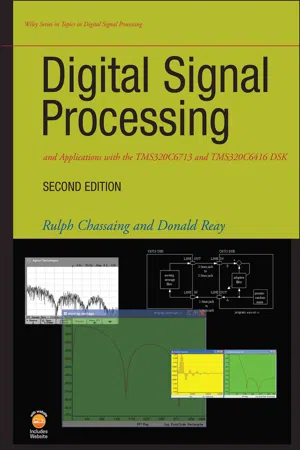
Digital Signal Processing and Applications with the TMS320C6713 and TMS320C6416 DSK
- English
- ePUB (mobile friendly)
- Available on iOS & Android
Digital Signal Processing and Applications with the TMS320C6713 and TMS320C6416 DSK
About this book
Digital Signal Processing and Applications with the TMS320C6713 and TMS320C6416 DSK
Now in a new edition—the most comprehensive, hands-on introduction to digital signal processing
The first edition of Digital Signal Processing and Applications with the TMS320C6713 and TMS320C6416 DSK is widely accepted as the most extensive text available on the hands-on teaching of Digital Signal Processing (DSP). Now, it has been fully updated in this valuable Second Edition to be compatible with the latest version (3.1) of Texas Instruments Code Composer Studio (CCS) development environment. Maintaining the original's comprehensive, hands-on approach that has made it an instructor's favorite, this new edition also features:
- Added program examples that illustrate DSP concepts in real-time and in the laboratory
- Expanded coverage of analog input and output
- New material on frame-based processing
- A revised chapter on IIR, which includes a number of floating-point example programs that explore IIR filters more comprehensively
- More extensive coverage of DSP/BIOS
- All programs listed in the text—plus additional applications—which are available on a companion website
No other book provides such an extensive or comprehensive set of program examples to aid instructors in teaching DSP in a laboratory using audio frequency signals—making this an ideal text for DSP courses at the senior undergraduate and postgraduate levels. It also serves as a valuable resource for researchers, DSP developers, business managers, and technology solution providers who are looking for an overview and examples of DSP algorithms implemented using the TMS320C6713 and TMS320C6416 DSK.
Frequently asked questions
- Essential is ideal for learners and professionals who enjoy exploring a wide range of subjects. Access the Essential Library with 800,000+ trusted titles and best-sellers across business, personal growth, and the humanities. Includes unlimited reading time and Standard Read Aloud voice.
- Complete: Perfect for advanced learners and researchers needing full, unrestricted access. Unlock 1.4M+ books across hundreds of subjects, including academic and specialized titles. The Complete Plan also includes advanced features like Premium Read Aloud and Research Assistant.
Please note we cannot support devices running on iOS 13 and Android 7 or earlier. Learn more about using the app.
Information
- Installing and testing Code Composer Studio Version 3.1
- Use of the TMS320C6713 or TMS320C6416 DSK
- Programming examples
Table of contents
- COVER
- TOPICS IN DIGITAL SIGNAL PROCESSING
- TITLE PAGE
- COPYRIGHT
- DEDICATION
- Preface
- Preface to the First Edition
- List of Examples
- Programs/Files on Accompanying CD
- 1: DSP Development System
- 2: Input and Output with the DSK
- 3: Architecture and Instruction Set of the C 6x Processor
- 4: Finite Impulse Response Filters
- 5: Infinite Impulse Response Filters
- 6: Fast Fourier Transform
- 7: Adaptive Filters
- 8: Code Optimization
- 9: DSP/BIOS and RTDX Using MATLAB, Visual C++, Visual Basic, and LabVIEW
- 10: DSP Applications and Student Projects
- A: TMS320C6x Instruction Set
- B: Registers for Circular Addressing and Interrupts
- C: Fixed-Point Considerations
- D: MATLAB and Goldwave Support Tools
- E: Fast Hartley Transform
- F: Goertzel Algorithm
- G: TMS320C6416 DSK
- INDEX
- END USER LICENSE AGREEMENT